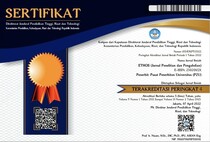2-D NUMERICAL STUDY OF HEAT TRANSFER CROSSFLOW ON SINGLE CIRCULAR CYLINDER AND TANDEM WITH TURBULENT VISCOSITY MODIFICATION
Abstract
The crossflow in cylinder marked by the phenomenon of stagnation point, shear layer separation and wake formation. Characteristics of flow regimes can be unsteady laminar flow (the formation of vortex shedding regime), transitional (regime with the transition to turbulent flow pattern in the wake area) and sub-critical (regime formation of the turbulent on shear layer). The value of the Reynolds number is very influential on the flow regimes characteristics of the flow, while the heat transfer process is heavily influenced by the value of Prandtl number. The amount of heat transfer is indicated by the parameter of Nusselt number. This study uses a numerical study by modifying the quantity of turbulent, ie the turbulent viscosity by interpreting UDF (user defined function). The results of numerical studies in the form of Nusselt number will be compared with the value of Nusselt number of experimental results and to create a basis consept for studying the mechanism of the flow phenomenon and heat transfer in the heat exchanger tube banks. The method used is a steady and unsteady 2-DRANS (Reynolds-averaged Navier Stokes) numerical simulations with 3 modeling, namely the standard k-є, standard k-ω and SST k-ω turbulence models.
Keywords
Full Text:
PDF (Bahasa Indonesia)References
Beaudan, P. and Moin, P. (1994), Numerical Experiments on The Flow past a Circular Cylinder at Sub- Critical Reynolds Number, Research in Stanford University California.
Durbin,P.A. (1996), On the k-є stagnation point anomaly, International Journal Heat and Fluid Flow, Vol. 17, no.1, February 1996
El Gharbi, N., et.al. (2015), Numerical optimization oh heat exchangers with circular and non-circular shapes, Case Studies in Thermal Engineering 6 (2015) 194-203
Kieft, R., et.al. (2007), Near-wake effects effects of a heat input on the vortex-shedding mechanism, International Journal of Heat and Fluid Flow 28 (2007) 938-947.
Lowery, G.W. and Vachon, R.I. (1974). The Effect of Turbulence on Heat Transfer from Heated Cylinder, International Journal of Heat and Mass Transfer, Vol. 18:p. 1229-1242
Medic,G. and Durbin,P.A. (2002), Toward Improved Prediction of Heat Transfer on Turbine Blades, Journal of Turbomachinery, 2002, Vol. 124, 187-192.
Roshko A. (1953), On the Development of Turbulent Wakes From Vortex Streets, (1953) Supersedes NACA TN 2913.
Sarkar, S., et.al. (2011), Unsteady wake dynamics and heat transfer in forced and mixed convection past a circular cylinder in cross flow for high Prandtl numbers, International Journal of Heat and Mass Transfer 54 (2011)3536-3551.
Szczepanic, K.,et.al. (2004), A Numerical Study of Heat Transfer from a Cylinder in Crossflow, 15th Australasian Fluid Mechanics Conference, 13-17 December 2004
Sanijai, S., and Goldstein, R.J. (2004), Forced convection heat transfer from a circular cylinder in crossflow to air and liquids, International Journal of Heat and Mass Transfer 47 (2004) 4795–4805.
Scholten, J.W. and Murray,D.B. (1998), Unsteady Heat Transfer and Velocity of a Cylinder in Cross Flow – I. Low Freestream Turbulence, International Journal of Heat and Mass Transfer, 1998, 41, (10), 1139-1148.
DOI: https://doi.org/10.29313/ethos.v0i0.2238
Refbacks
- There are currently no refbacks.
Alamat Redaksi:
LPPM Unisba, Lantai 2, Jl. Purnawarman 63, Bandung 40116, Jawa Barat, (022) 4203368 , (022) 4264064. ethos.unisba@gmail.com / ethos@unisba.ac.id

This work is licensed under a Creative Commons Attribution-NonCommercial-ShareAlike 4.0 International License.














